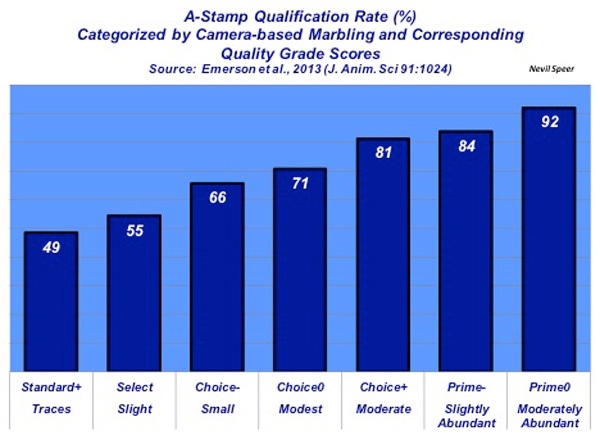Cattle that qualify for USDA’s A-stamp are more likely to produce a higher-value carcass.
June 5, 2013

Several weeks ago, BEEF’s Industry-At-A-Glance featured some recent research regarding the use of camera-based technology to assess marbling score. That feature also included some discussion about the importance of USDA Quality Grade (QG) and its inherent relationship to consumer satisfaction.
That same research, which was commissioned by the Cattlemen’s Beef Board, also reveals some interesting findings related to QG and the slaughter mix. Most notably, higher degrees of marbling are positively associated with USDA’s A-stamp qualification rate (USDA’s designation for cattle that are predominantly black in color). Specifically, the A-stamp rate for Traces, Slight, Small, Modest, Moderate, Slightly Abundant and Moderately Abundant marbling scores are 49, 55, 66, 71, 81, 84 and 92%, respectively.
Stated another way, as marbling score (and corresponding QG) improves, there’s a greater probability the product is sourced from cattle that possess an A-stamp. Alternatively, cattle that qualify for the A-stamp are more likely to produce a higher-value carcass.

Seemingly, that reality has also pervaded the perception among various sectors when asked about the definition and/or description of “genetics.”The most cited response among retailers, foodservice, packers and feeders in the National Beef Quality Audit, for instance, was “primarily black-hided.”
How do you perceive these findings and various USDA-certified programs upon consumer perceptions? What influence will that have upon beef marketing in the future? Will it play a bigger role in genetic and management decisions going forward, or do you think such demand will plateau because of market saturation? Leave your thoughts below.
You might also like:
Smithfield Foods Sells To Chinese Hog Company
15 Best Photos Featuring Ranch Sweethearts
New FDA Guidance Will Alter Cattle Feed Additive Usage In Your Feedyard
About the Author(s)
You May Also Like





